How to Use the Reciprocity Schedule for Non-U.S. Documents
Step-by-step instructions (with images) for accessing the State Department’s Reciprocity Schedule — plus helpful tips
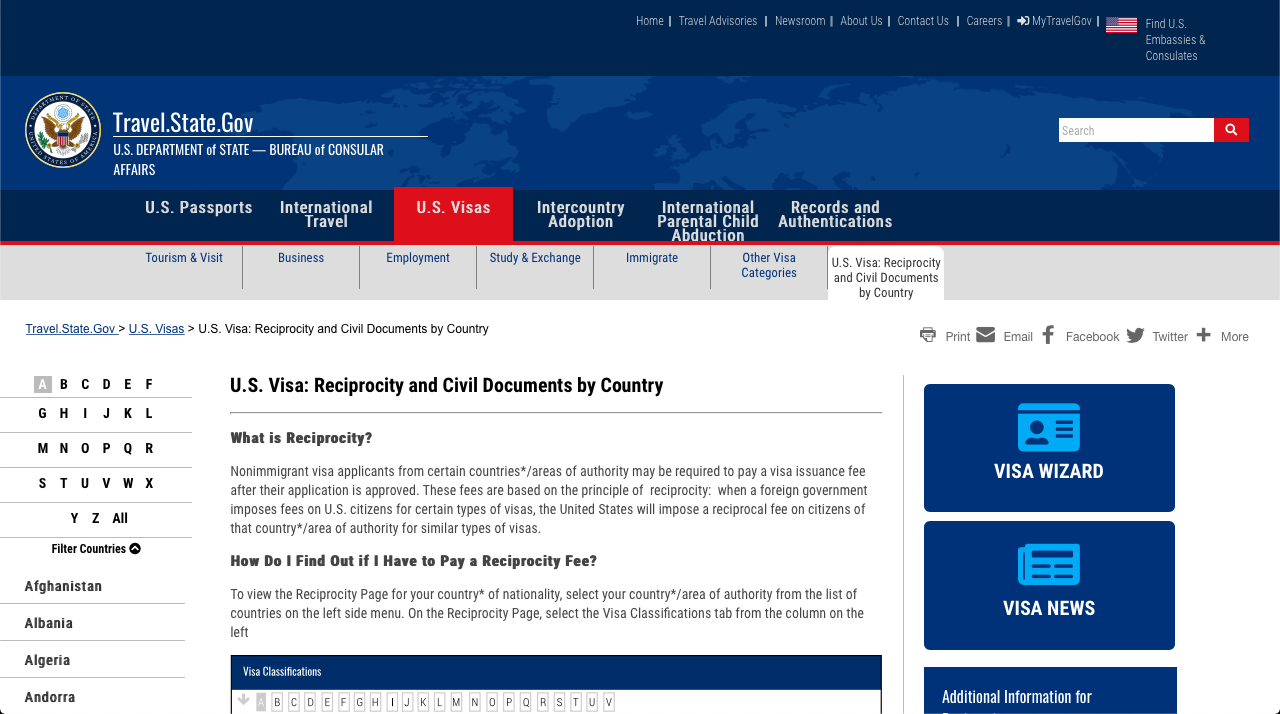
What is the Reciprocity Schedule?
The Reciprocity Schedule — maintained by the U.S. Department of State — provides specific guidance for obtaining supporting (civil) documents for green card applications. It shows the availability of a document, where and how much it costs to obtain an official copy, and other important details based on the country where the document was issued.
Important:
If your document was issued in a country other than the United States, always check the Reciprocity Schedule first to make sure you have the correct version before submitting it to the U.S. government. Documents that don’t meet the Reciprocity Schedule guidelines often are rejected by the U.S. government or result in an official Request for Evidence (RFE), which can significantly delay an application.
How to Use the Reciprocity Schedule
Follow the instructions below to navigate the Reciprocity Schedule.
Note:
This guide is relevant only to people applying for green cards (immigrant visas). The Reciprocity Schedule contains additional information for people applying for nonimmigrant visas, which is not covered by this guide.
Step 1. Open the Reciprocity Schedule.
Visit the State Department’s “U.S. Visa: Reciprocity and Civil Documents by Country” webpage. It should look like this:
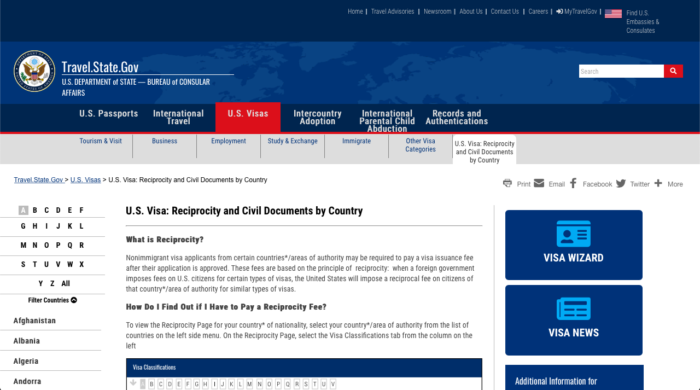
Step 2. Filter by country.
On the left-hand side of the page, click the letter corresponding with the first letter of the country where your document was issued, or click “All” to see the full list of countries in alphabetical order.
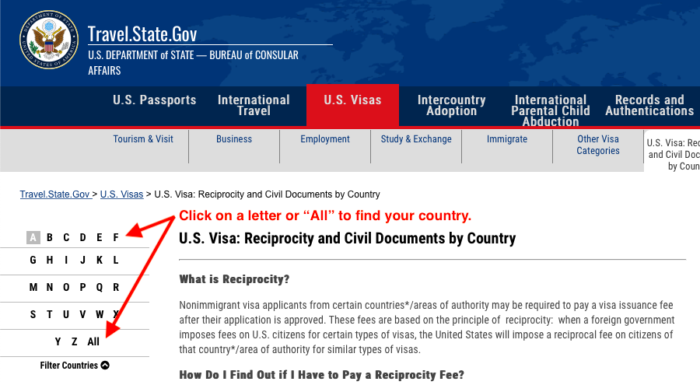
Step 3. Look for your country.
Scroll down until you see the country that issued your document in the list below the alphabet.
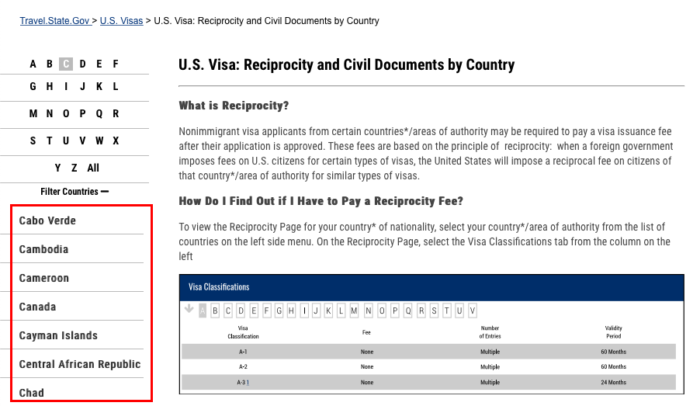
Step 4. Select your country.
Click on the country that issued your document. You should arrive at a page that looks like this:
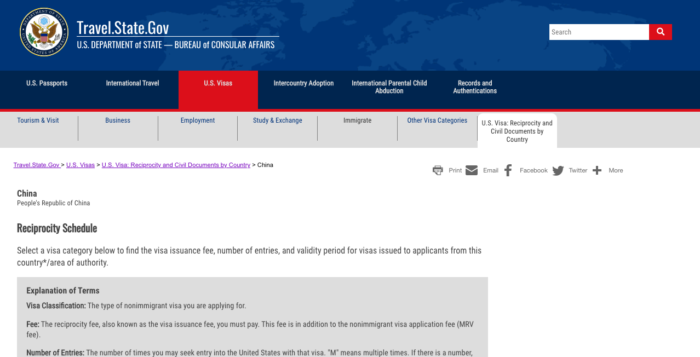
Important:
Skip the “Explanation of Terms” and “Visa Classifications” section, which are relevant only to people applying for nonimmigrant visas, not green cards (immigrant visas). What they look like:
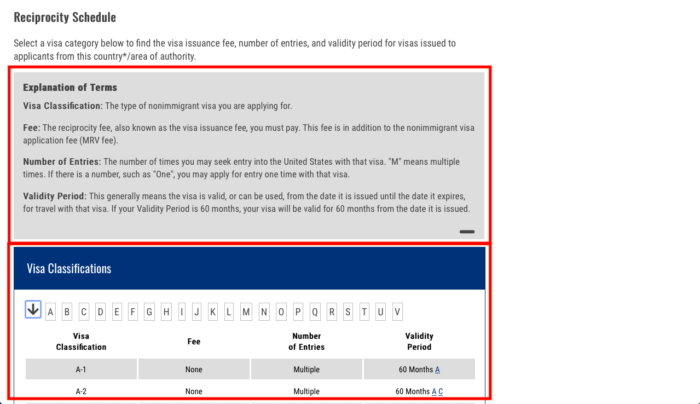
Step 5. Search for your document.
Scroll down until you see the name of your document, and click on the plus (+) sign at the right end of the gray bar. (Some documents, such as marriage and divorce certificates, are grouped together.) What you should see:
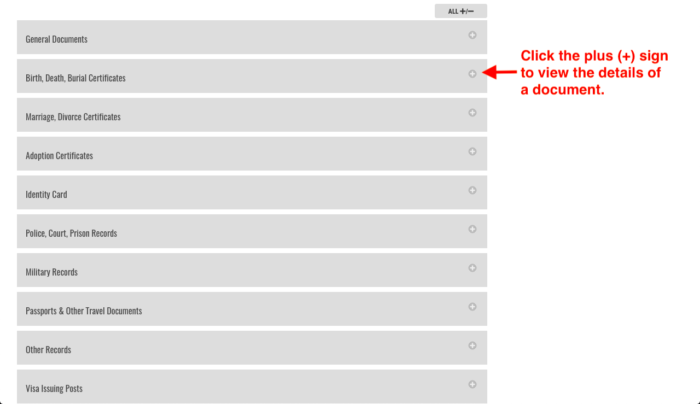
Step 6. View the document details.
The expanded box will show whether a document is “Available,” along with other relevant information. See “Understanding the Terminology” below to learn what each notation means. (Click here if your document is not available.) What you should see:
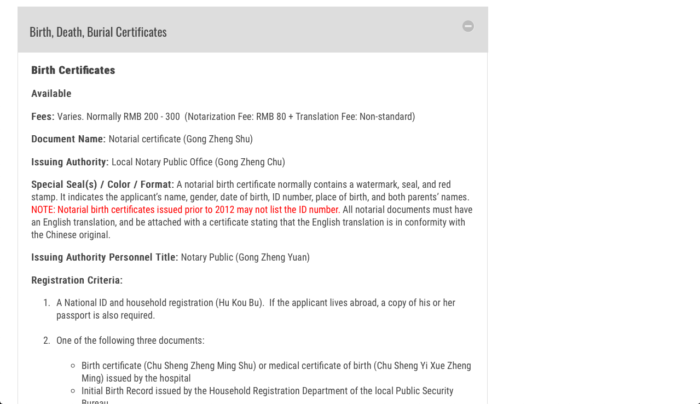
Important:
You must still provide whatever form of this document you have, an alternative, or a written statement explaining why you cannot provide the document if the U.S. government requires it for your green card application. What you might see:

With Boundless, you get the confidence of an independent immigration attorney who reviews your entire family-based or marriage-based green card application package, including all of your documents — for no additional fee. Learn more about how Boundless can help you, or get started now!
Understanding the Terminology
Like other government resources, the Reciprocity Schedule is filled with jargon and technical terms that can be hard to understand.
Below, we’ve spelled out common terms typically found under each document. Click on a term to learn what it means, including helpful examples. (Keep in mind that not all countries’ guidance will be organized by these terms and the information shown for each will vary by country.)
- Fees
- Document Name
- Issuing Authority
- Format (or Special Seal(s)/Color/Format)
- Issuing Authority Personnel Title
- Registration Criteria
- Procedure for Obtaining
- Certified Copies Available
- Alternate Documents
- Exceptions
- Comments
Fees (not to be confused with the nonimmigrant visa fee listed under the “Visa Classifications” section)
What it means: How much it costs to obtain a certified or an official copy of the document, acceptable payment types, and/or the appropriate contacts for obtaining this information
Example
For birth certificates issued in the Bahamas, there is no available fee schedule in the Reciprocity Schedule. To obtain fee info, applicants are instructed to “check with the Bahamian consular office nearest their place of residence” or email the government.
Document Name
What it means: The official name used by the issuing country to refer to the document
Example
In Bangladesh, a marriage certificate issued to a Muslim couple is officially called a “Nikah Nama.”
Issuing Authority
What it means: The name of the government agency that issues the document
Example
In the Philippines, the government agency that issues birth, death, and marriage certificates is called the “Philippine Statistics Authority (PSA).”
Format (or Special Seal(s)/Color/Format)
What it means: Specific design elements, the way the information is organized, or the unique contents of a document that help distinguish an official copy
Example
A marriage certificate issued to a Muslim couple in Bangladesh is usually printed on a Bangladesh government-issued blue form (Form 1601).
Issuing Authority Personnel Title
What it means: What the employee responsible for issuing the document is officially referred to (in many countries, there is no specific worker who issues the document, only a government agency)
Example
In France, the employee who issues divorce certificates is called the “Tribunal de Grande Instance (TGI).”
Registration Criteria
What it means: The typical process for registering a document with the issuing government agency, including, in some cases, who may do so and within what timeframe — in other words, if the issuing agency has a copy of your document, this is the registration process you would have followed (though some documents, such as police certificates, are not registered by individuals but by the authority itself)
Example
In Ghana, the registration instructions for a marriage certificate vary based on whether the marriage took place according to a specific “ethnic group’s customary law” or whether it was a civil or an Islamic marriage.
Procedure for Obtaining
What it means: Often points to the issuing agency’s online instructions or lists whom to contact; in some cases, it also describes who can obtain a document and what information they must provide
Example
In France, anyone “who has resided in France at any time […] after the age of 15” may request adoption papers. To do so, they must provide their “full name, and any other names (including maiden), by which known, date and place of birth, father’s full name, mother’s maiden and married names, and place of residence.”
Certified Copies Available
What it means: Whether (and, in some cases, where) a government-issued copy of a document may be requested
Alternate Documents
What it means: Other documents that can satisfy the U.S. government’s requirement for a specific type of document
Example
In lieu of an unobtainable birth certificate issued in Austria, the U.S. government will accept a baptismal certificate, or “Taufscheine.”
Exceptions
What it means: Why a document is not available for particular groups of people because of certain laws or other reasons
Example
In Myanmar (formerly Burma), divorce certificates are not available for all couples. Records of a Buddhist divorce, specifically, only exist if the divorce is contested because the separation of Buddhist couples traditionally occurs “without judicial involvement and without making a written record.”
Comments
What it means: Additional details about a document; in some cases, the comments provide legal or historical context affecting the existence of a document
Example
In Argentina, “There are two types of birth records,” but the U.S. government requires the “Acta de Nacimiento,” not the “Certificado de Nacimiento.”
Boundless assembles your entire family-based or marriage-based green card filing package, including all required documents, and mails it to your doorstep with clear instructions. Learn more about how Boundless can help you, or check your eligibility for a marriage-based green card.
Helpful Tips
Provide other evidence.
If you can’t access a certain supporting document — either because you don’t have the original copy or the issuing agency cannot supply a certified copy — you’ll need to provide the “Alternate Documents” listed in the Reciprocity Schedule, if specified, or secondary evidence.
Use what you have.
You must provide a document to the U.S. government even if: a) you’re unable to get a certified copy or secondary evidence or b) the document is marked “Unavailable” or “N/A” in the Reciprocity Schedule.
In such cases, the U.S. government generally provides more leeway, so it’s best to submit whatever document you already have or can obtain from your local government agency or other issuing authority. This will help prevent an official Request for Evidence (RFE) or rejection of the document by the U.S. government, which can cause significant delays.
Don’t forget translations.
The U.S. government requires a certified English translation of any document written in a language other than English.
If you’re a Boundless customer, our partner RushTranslate can help with your translation needs. Click here to learn more about their services and pricing.
Disclosure
Boundless may earn a referral fee if you decide to purchase a product or service after clicking a link to one of our partner providers.
Review the “General Documents” tab.
For most countries, this tab (at the top of the document list) will simply display “no general information.” In some cases, the State Department uses this section to share important alerts affecting your ability to obtain a document, such as in this example for Afghanistan (obtained July 10, 2020):

Don’t skip over the “Comments.”
The comments under each document type, if available, often provide important context. In some countries, certain documents may not be available due to national laws or customs. For example, because divorce is not legal for Hindu and Buddhist couples in Bangladesh, divorce records can be obtained only “from a country where Hindu or Buddhist divorces are recognized.”
Don’t wait to request documents.
Gathering documents can be one of the most burdensome steps of the immigration process, but it’s also one of the most critical. If the U.S. government requires a non-U.S.-issued document, it’s best to request a copy right away to avoid delays or complications with your application.
Consult your immigration attorney.
If you don’t find a document listed or have trouble comprehending certain guidance in the Reciprocity Schedule, reach out to your immigration attorney.
Boundless-network independent attorneys each have several years of experience in family immigration law, including a large number of successful application filings. This lends them unique insight into the types of documents that the U.S. government looks for — and any special requirements — based on their clients’ situation.
Boundless helps guide you through the entire family-based or marriage-based green card process, including gathering all of your documents together and uploading them to your secure Boundless online account. Read more about what you get with Boundless, or start your application.
In the context of U.S. immigration, “reciprocity” typically refers to the principle that the U.S. will apply the same immigration policies to citizens of a given country as that country applies to U.S. citizens.
For example, if Country A has stringent visa requirements for U.S. citizens, the U.S. might reciprocally apply similarly stringent requirements for citizens of Country A wishing to travel or immigrate to the U.S. Conversely, if Country B offers visa-free travel to U.S. citizens, the U.S. might reciprocally offer visa-free travel to citizens of Country B.
The method of payment can vary by location. In some cases, you may be asked to pay the fee directly at the embassy or consulate, while in other cases, you might need to pay online or at a designated bank. You should follow the specific instructions given to you by the embassy or consulate.